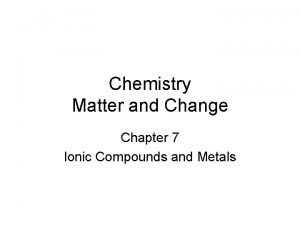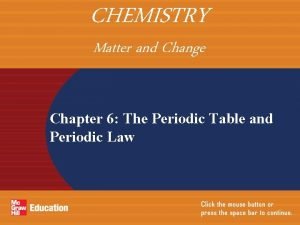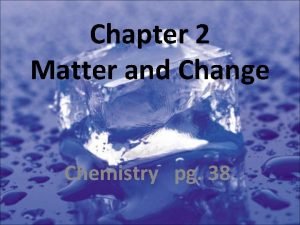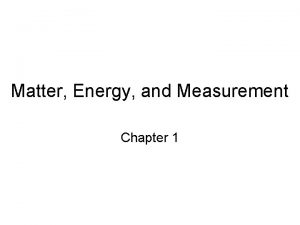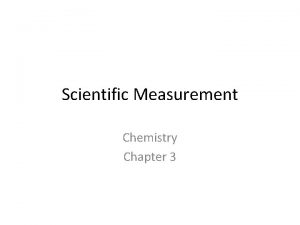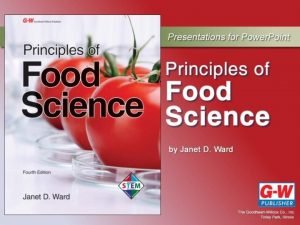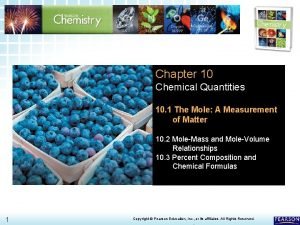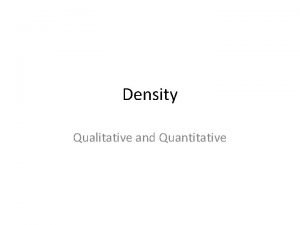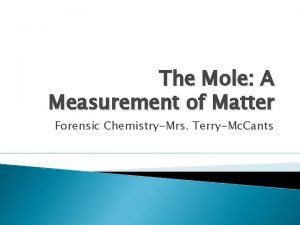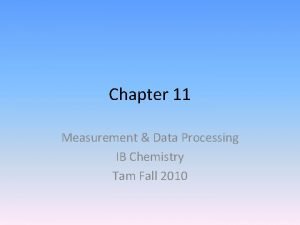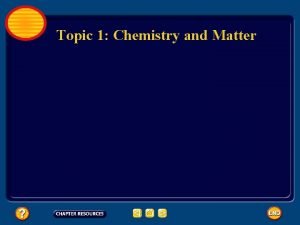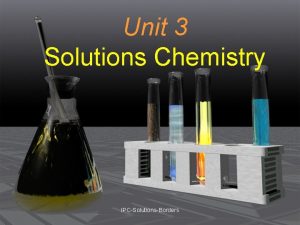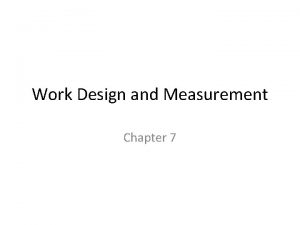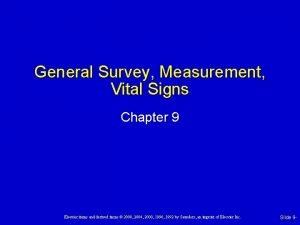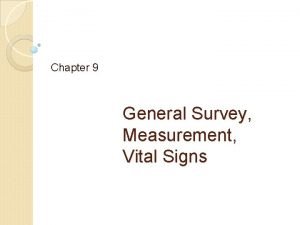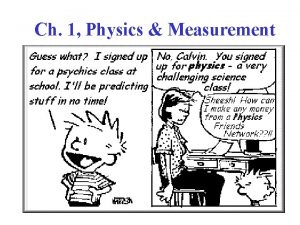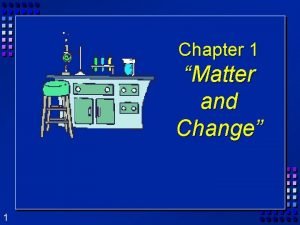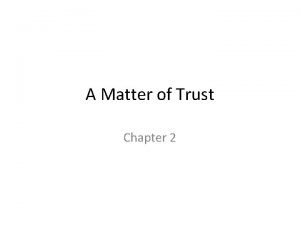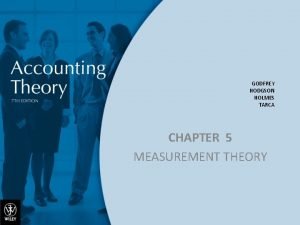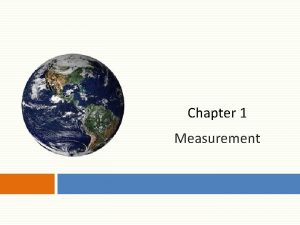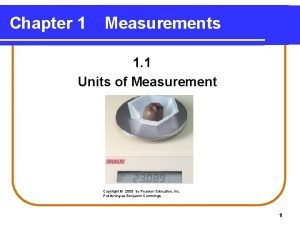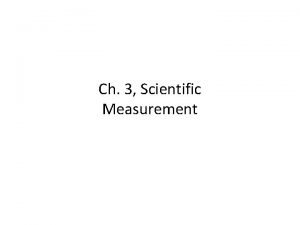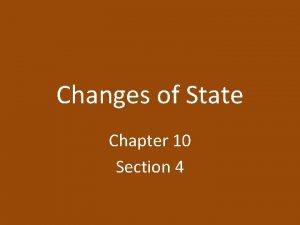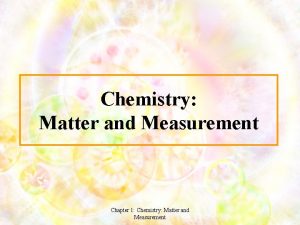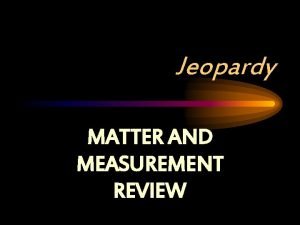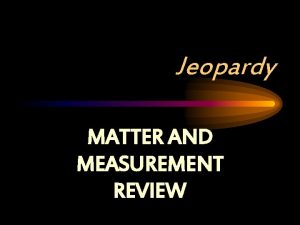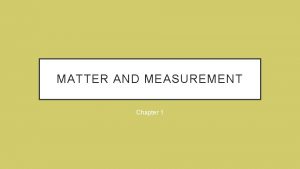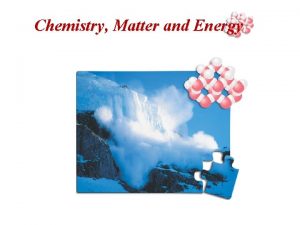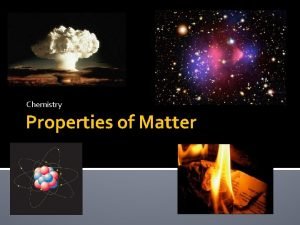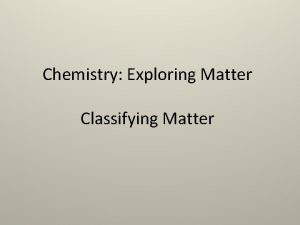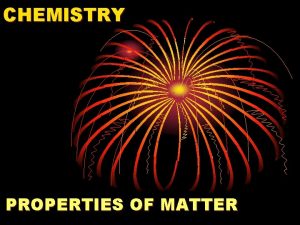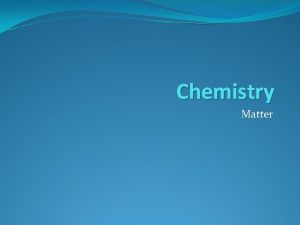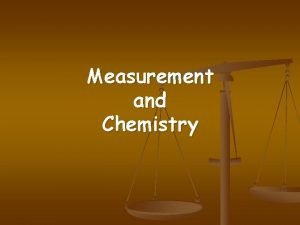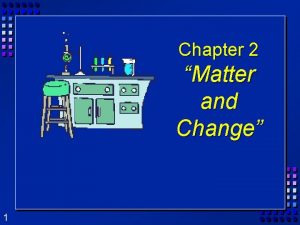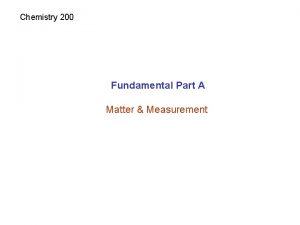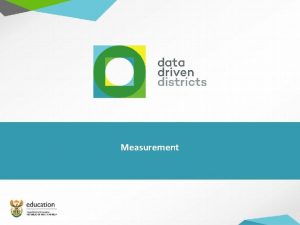Chapter 1 Chemistry Matter and Measurement Chemistry Are


















































- Slides: 50

Chapter 1 Chemistry: Matter and Measurement

Chemistry • Are you a gambler? • Chemistry – The Central Science – Chemistry is the study of matter, its properties, and its transformations

Matter • Matter – any substance that has a mass and volume (takes up space) • 3 States of matter – Solid – Liquid – Gas

Matter

Matter • Element – the fundamental unit of all substances – Found on the Periodic table – Unique name and symbol • First letter of symbol is capitalized, the second is always lower case – Review the Periodic Table powerpoint for more information about the periodic table

Matter • Compounds – Formed when elements combine in a specific ratio – Chemical Formula - A notation for a chemical compound using symbols and subscripts to show the exact ratio of atoms of each element that are present.

Matter • Mixture – The combination of more than one pure substance • Homogenous • Heterogeneous

Example Problem • Which of the following is not an example of an element? – A. Ni – B. O 2 – C. CO – D. S 8 – E. Co

Example Problem • The chemical formula Co. SO 4 indicates the compound contains: – A. 1 carbon, 1 sulfur, 5 oxygens – B. 1 carbon, 1 sulfur, 4 oxygens – C. 1 cobalt, 1 sulfur, 4 oxygens – D. 1 copper, 1 sulfur, 4 oxygens – E. 1 cobalt, 1 sulfur, 5 oxygens

Example Problem • Which of the following is not a mixture. – Pure blood – Bread – Toothpaste – Aluminum foil – Motor oil

Identification of Matter • Matter is identified according to – Physical and chemical properties

Identification of Matter • Physical properties – those that can be described without altering chemical composition • Chemical properties – indicate how a chemical reacts under a set of conditions

Identification of Matter PHYSICAL CHEMICAL Description by senses – shape, color, odor, soluble, miscible, etc. -Burns Measurable properties – density, boiling point, acidity, etc. -Decomposition -Oxidizes

Example Problem • Which of the following is a physical property of aspirin? A) Aspirin can moderate some heart disorders when ingested. B) Aspirin does not decompose when tightly sealed in a bottle. C) Aspirin yields carbon dioxide and water vapor when burned. D) Aspirin can be pressed into tablets when mixed with cornstarch. E) Aspirin reacts with water to produce salicylic acid and acetic acid.

Questions to be Answered • What does a measurement involve? • How do you make measurements properly? • How do we convert between measurements of one unit to measurements of a new unit?

Physical Quantities • Physical quantities – measured physical properties – Number – Unit

Proper Measurements • Number – Reflect the certainty to which the measurement was made • Unit – Represent the type of measurement made • Mass • Volume • Length

Measurement and Significant Figures • Number – Certain digits - all digits that can be stated as fact • Read from smallest digit – One Uncertain digit – the first digit that is estimated • No additional digits should be recorded – Ruler practice – Uncertainty always exist in the last digit of a number • Balance example

Measurement and Significant Figures • The total number of digits used to express such a measurement is the number of significant figures.

Measurement and Significant Figures Instrument used directly impacts the certainty of the measurement and hence the # of significant figures that can be reported.

Scientific Notation • Scientific notation - convenient way to write a very small or a very large number. – All digits listed in the number portion are significant • Rules for conversion – Move decimal so that it follows first non-zero digit – Write all sig figs in number followed by (x 10) – Raise the ten to the appropriate power • Decimal moved left (+) the number of places moved • Decimal moved right (-) the number of places moved

Physical Quantities

Physical Quantities

Measuring Mass • Mass is a measure of the amount of matter in an object. Mass does not depend on location. • Weight is a measure of the gravitational force acting on an object. Weight depends on location. • Chemist measure grams or milligrams

Measuring Length and Volume • Length has the SI unit of meter (m) • Volume = length x width x height – Units – m 3 – Chemist tend to use milliliters (m. L) or Liters (L)

Measurement and Significant Figures • When reading a measured value – All nonzero digits are significant. – Zero’s • RULE 1. Zeros in the middle of a number are they are always significant. • RULE 2. Zeros at the beginning of a number are not significant • RULE 3. Zeros at the end of a number and after the decimal point are significant. • RULE 4. Zeros at the end of a number and before an implied decimal point may or may not be significant. We cannot tell whether they are part of the measurement or whether they act only to locate the unwritten but implied decimal point. – If a decimal point is shown the zero’s are significant

Problem • Which measurement is expressed to 4 significant figures? – A. 0. 00423 kg – B. 24. 049 cm – C. 1300 K – D. 82, 306 m – E. 62. 40 g

Performing Problems with Measurements • Why are significant figures important? • How do we convert from one unit to another?

Rounding Off Numbers • Often when doing arithmetic on a calculator, the answer is displayed with several digits. – Example - 13. 6 / 28 • How many do you keep?

Rounding Off Numbers • RULE 1. Multiplication or Division – the answer cannot have more significant figures than the original number with the fewest.

Rounding Off Numbers • RULE 2. Addition or Subtraction – the answer cannot have more digits after the decimal point than the original number with the fewest.

Rounding Off Numbers • Once you decide how many digits to retain, the rules for rounding off numbers are straightforward: – If the first number dropped is: • 4 or less – let it rest • 5 or more – let it score

Problem • The appropriate number of significant figures in the result of 15. 234 - 15. 208 is – A. 1 – B. 2 – C. 3 – D. 4 – E. 5

Problem • Select the answer that expresses the result of this calculation with the correct number of significant figures. – – – A. 13. 3568 B. 13. 357 C. 13. 36 D. 13. 4 E. 13

Problem • The result of (3. 8621 × 1. 5630) - 5. 98 is properly written as – A. 0. 06 – B. 0. 056 – C. 0. 0565 – D. 0. 05646 – E. 0. 056462

Converting a Quantity from One Unit to Another • Factor-Label Method: (Starting quantity) x (Conversion factor) = Equivalent quantity

Converting a Quantity from One Unit to Another • What is a conversion unit – Ratios, fractions, or two measured quantities that are equivalent – Equal 1 • The important item in these numbers are UNITS

Example • How many kilometers is 26. 22 miles? – STEP 1: Identify the information given. – STEP 2: Identify the information needed to answer. – STEP 3: Find the relationship(s) between the known information and unknown answer, and plan a series of steps, including conversion factors, for getting from one to the other. – STEP 4: Solve the problem. – BALLPARK CHECK: Make a rough estimate to be sure the value and the units of your calculated answer are reasonable.

Problem • The distance between carbon atoms in ethylene is 134 picometers. Which of the following expresses that distance in meters? – A. 1. 34 × 10 -13 m – B. 1. 34 × 10 -12 m – C. 1. 34 × 10 -10 m – D. 1. 34 × 10 -7 m – E. 1. 34 × 10 -6 m

Problem • A dose of medication was prescribed to be 35 microliters. Which of the following expresses that volume in centiliters? – A. 3. 5 × 105 c. L – B. 3. 5 × 104 c. L – C. 3. 5 c. L – D. 3. 5 × 10 -4 c. L – E. 3. 5 × 10 -3 c. L

Problem • The average distance between the Earth and the Moon is 240, 000 miles. Express this distance in kilometers. – A. 6. 1 × 105 km – B. 5. 3 × 105 km – C. 3. 9 × l 05 km – D. 1. 5 × 105 km – E. 9. 4 × 104 km

Problem • The speed needed to escape the pull of Earth's gravity is 11. 3 km/s. What is this speed in mi/h? – A. 65, 500 mi/h – B. 25, 300 mi/h – C. 18, 200 mi/h – D. 1, 090 mi/h – E. 5. 02 × 10 -3 mi/h

Measuring Temperature • 3 scales – Fahrenheit – Celsius – Kelvin

Measuring Temperatures • Converting Between Temperature Scales – o. F = (1. 8 x o. C) + 32 – K = o. C + 273. 15

Problem • Isopropyl alcohol, commonly known as rubbing alcohol, boils at 82. 4°C. What is the boiling point in kelvins? – A. 387. 6 K – B. 355. 6 K – C. 323. 6 K – D. 190. 8 K – E. -190. 8 K

Problem • Acetic acid boils at 244. 2°F. What is its boiling point in degrees Celsius? – A. 382. 0°C – B. 167. 7°C – C. 153. 4°C – D. 117. 9°C – E. 103. 7°C

Density • Density relates the mass of an object to its volume. – Units • grams per cubic centimeter (g/cm 3) for solids • grams per milliliter (g/m. L) for liquids. Density = Mass (g) Volume (m. L or cm 3)

Density • If the gasoline in a full 20. 0 gallon tank weighs 116 lb, what is the density of gasoline in g/m. L • How many grams does 1. 2 L of water weigh, if at room temperature water has a density of 0. 9970 g/cm 3

Optional Homework • 1. 20, 1. 25, 1. 27, 1. 36, 1. 38, 1. 40, 1. 42, 1. 44, 1. 60, 1. 62, 1. 64, 1. 66, 1. 68, 1. 70, 1. 71, 1. 72, 1. 78, 1. 80, 1. 82, 1. 86, 1. 88, 1. 90, 1. 94, 1. 102 • Chapter 1 Homework – from website

Required Homework • Read Sections 1. 2, 1. 3, and 1. 4 • Review the Periodic Table Powerpoint • Assignment #1 – from website
 Insidan region jh
Insidan region jh Chapter 2 matter section 1 classifying matter answer key
Chapter 2 matter section 1 classifying matter answer key Chemistry matter and change chapter 7
Chemistry matter and change chapter 7 Chemistry matter and change chapter 10
Chemistry matter and change chapter 10 Chemistry matter and change chapter 7
Chemistry matter and change chapter 7 Chemistry matter and change chapter 6
Chemistry matter and change chapter 6 Chemistry matter and change chapter 10
Chemistry matter and change chapter 10 Chemistry matter and change chapter 2 answer key
Chemistry matter and change chapter 2 answer key Matter energy and measurement
Matter energy and measurement Chemistry chapter 3 scientific measurement
Chemistry chapter 3 scientific measurement Meysam golmohammadi
Meysam golmohammadi Primary taste cortex
Primary taste cortex Gray matter and white matter
Gray matter and white matter Ncl. caudatus
Ncl. caudatus Chapter 4 basic food chemistry the nature of matter
Chapter 4 basic food chemistry the nature of matter Chapter 4 basic food chemistry the nature of matter
Chapter 4 basic food chemistry the nature of matter Foods that are heterogeneous mixtures
Foods that are heterogeneous mixtures The mole a measurement of matter
The mole a measurement of matter 10.1 the mole a measurement of matter
10.1 the mole a measurement of matter Density is an example of
Density is an example of The mole a measurement of matter
The mole a measurement of matter Ib chemistry measurement and data processing worksheets
Ib chemistry measurement and data processing worksheets Section 1 composition of matter
Section 1 composition of matter Section 1 composition of matter
Section 1 composition of matter Composition of matter section 1
Composition of matter section 1 Energy naturally flows from warmer matter to cooler matter.
Energy naturally flows from warmer matter to cooler matter. Definition of substance
Definition of substance Examples of matter in chemistry
Examples of matter in chemistry Matter flow chart
Matter flow chart Matter flowchart chemistry
Matter flowchart chemistry Graphic organizer matter classifications
Graphic organizer matter classifications Work design and measurement
Work design and measurement Chapter 9 general survey and measurement
Chapter 9 general survey and measurement Blood pressure child normal range
Blood pressure child normal range Unit of measurement for power
Unit of measurement for power Physics and measurement chapter 1
Physics and measurement chapter 1 Chapter 1 review matter and change
Chapter 1 review matter and change A matter of trust book summary
A matter of trust book summary Circle the solute and underline the solvent
Circle the solute and underline the solvent Chapter 11 - states of matter: liquids and solids
Chapter 11 - states of matter: liquids and solids Functional groups ib chemistry
Functional groups ib chemistry Inorganic vs organic chemistry
Inorganic vs organic chemistry Chapter 5 measurement theory godfrey
Chapter 5 measurement theory godfrey Chapter 8 section 3 earthquakes and society answer key
Chapter 8 section 3 earthquakes and society answer key Chapter 1 measurement
Chapter 1 measurement Chapter 1 measurement
Chapter 1 measurement Chapter 3 scientific measurement
Chapter 3 scientific measurement Progress and performance measurement and evaluation
Progress and performance measurement and evaluation Evaluation in progress
Evaluation in progress Chapter 12 states of matter
Chapter 12 states of matter Chapter 10 review states of matter section 4
Chapter 10 review states of matter section 4




